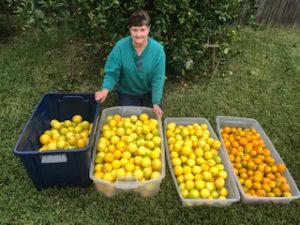Valentine’s Day, Mother’s Day and Father’s Day are the three important dates citrus trees are fertilized.
Each year a tree is alive accounts for the needed amount of fertilizer. Newly planted trees are fertilized after 6 weeks or when new growth begins. A one-year old tree uses 1- 1 ½ pounds of fertilizer, a 2-year old tree uses 2-3 pounds, and a 3-year-old tree uses 3-4 ½ pounds. A 4-year-old tree uses 4-6 pounds and a 5-year-old tree uses 5-7 ½ pounds. A 6-year old tree uses 6-9 pounds and a 7-year-old tree uses 7-10.5 pounds. An 8-year-old tree uses 8-12 pounds and a 9- year-old uses 9-13.5 pounds. A 10-year-old tree uses 10-15 pounds and an 11-year-old uses 11-16.5 pounds. Twelve-year-old and older trees will use the top limit of fertilizer which is 12-18 pounds per tree. How much is a pound of fertilizer? A pound of dry granulated fertilizer is equal to 2 cups or 1 pint.
Don’t put this fertilize all at once. To remember the amount of fertilizer to use on each of these special days is to divide the total amount of fertilizer needed a year by 3. Let’s use this example: A 10-year old tree uses 10-15 pounds of fertilizer. Fifteen divided by 3 equals 5 pounds for Valentine’s Day, 5 pounds for Mother’s Day, and 5 pounds for Father’s Day. One pound is 2 cups of fertilizer. Five pounds times 2 equals 10 cups of fertilizer needed for each day.
Most citrus growers in our area will use 13-13-13 fertilizer the first 3 years. The first 3 years the tree is to develop the root system. If fruit develops it is necessary to pick it off to allow for the root development. Trees 4 years and older can use 13-13-13 but 15-5-10 is the preferred fertilizer. Using a lowered phosphorous number is better for the coastal soils. A phosphorous buildup makes the tree unable to absorb needed nutrients like zinc and iron.
The last step is to fertilize the tree at the feeder roots. Fertilize beyond the spread of the limbs where most of the feeder roots occur. Put your shoulder next to the tree’s outer branches. Hold the fertilizer in the hand farther away from the tree branches. Walk around the tree and evenly spread the fertilizer in a 12-18-inch band on the outer branches of the tree. Water the fertilizer into the soil.
The cold hardiness of a citrus tree is compromised if fertilized after the end of June.
Reach Jefferson County Master Gardener Eileen Slater at [email protected] or call the Texas A&M AgriLife Extension Service at (409)835-8461.
